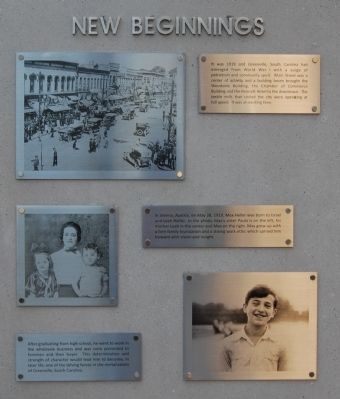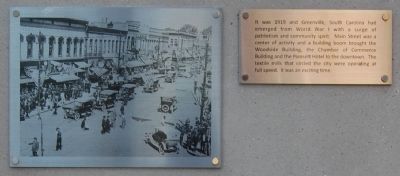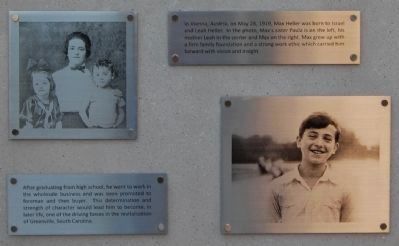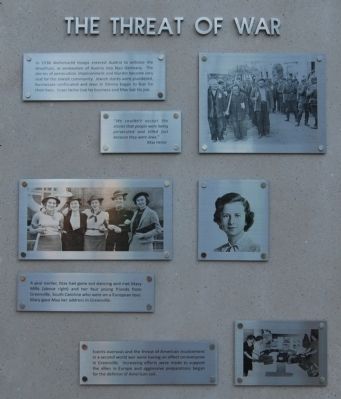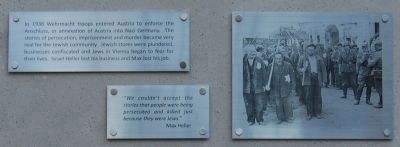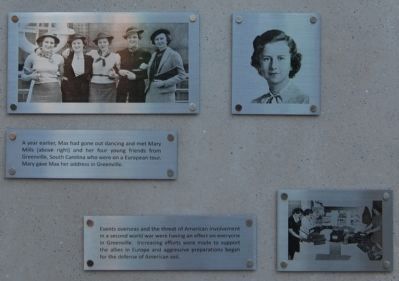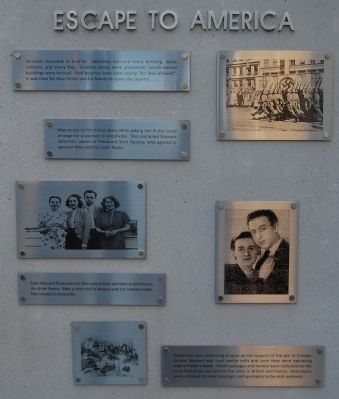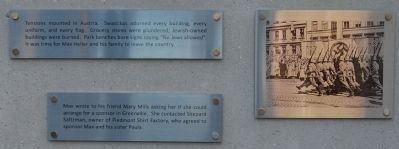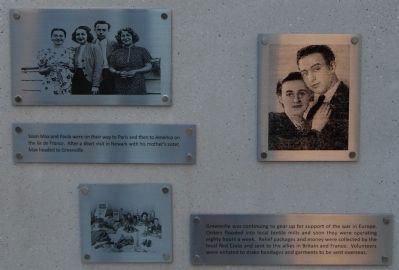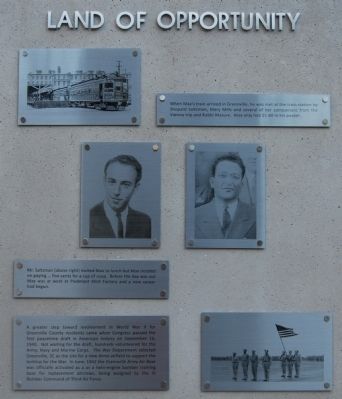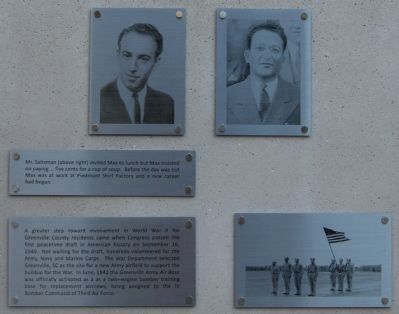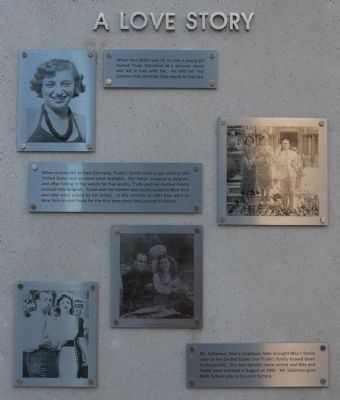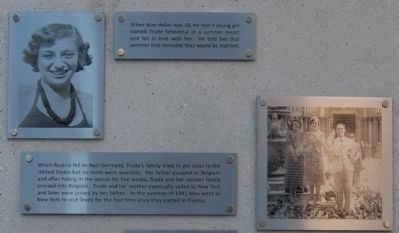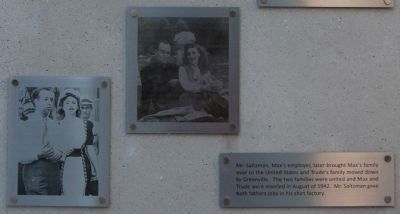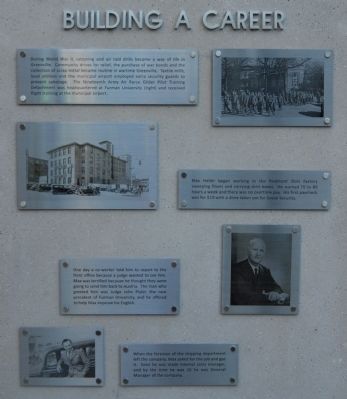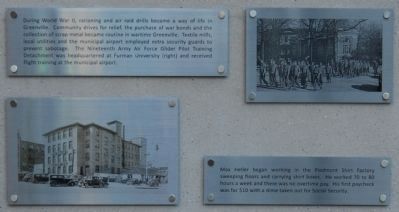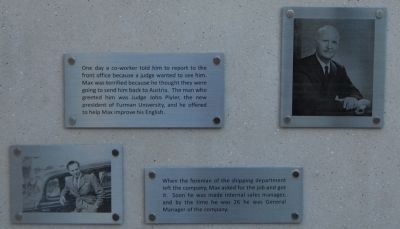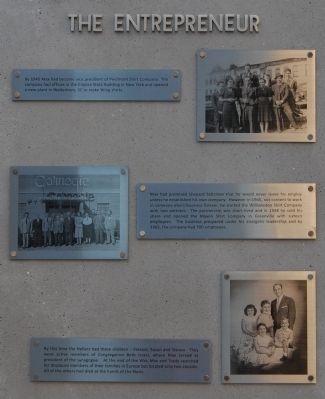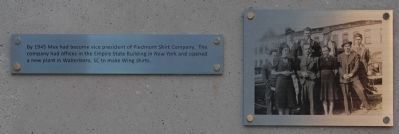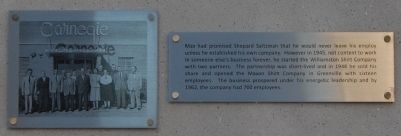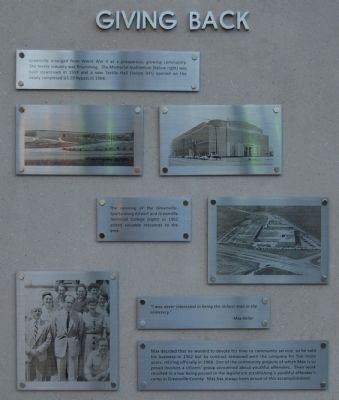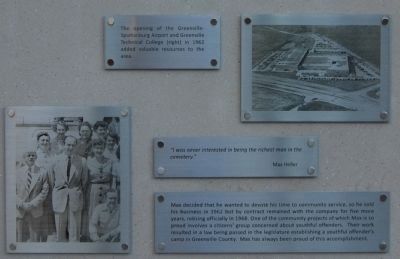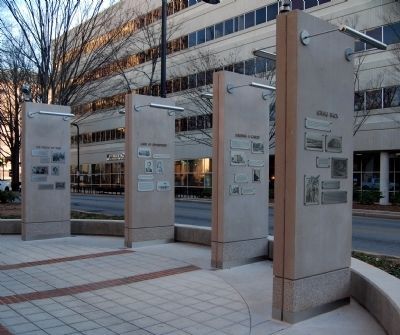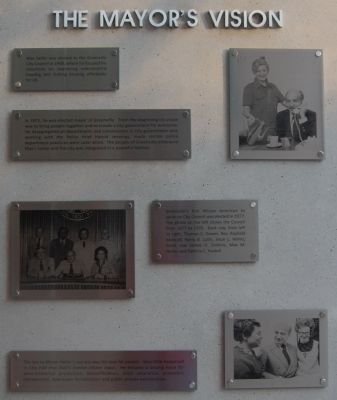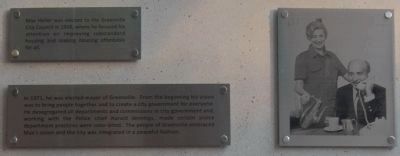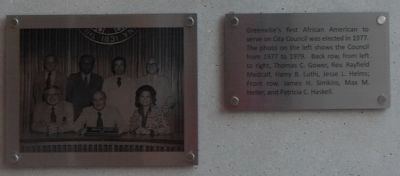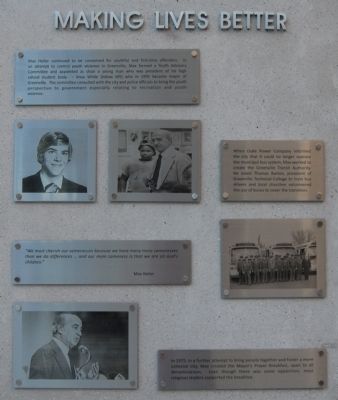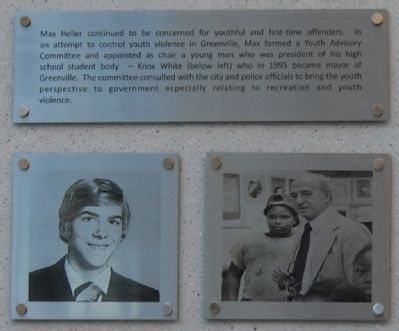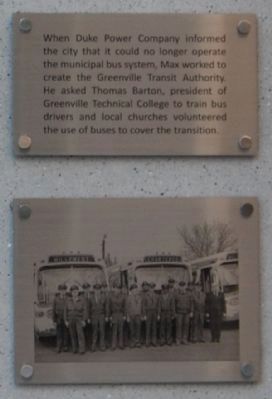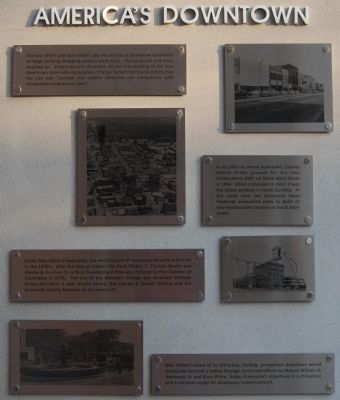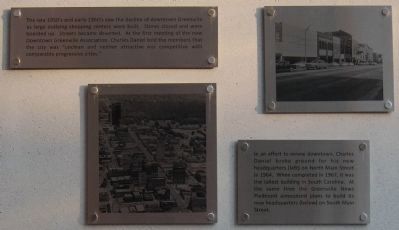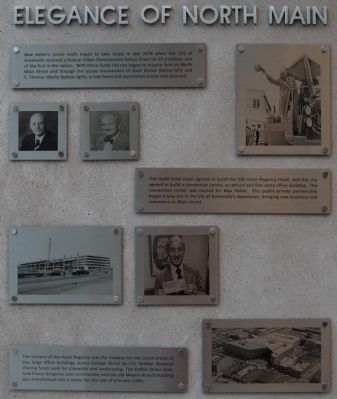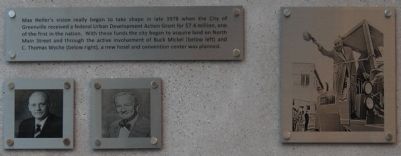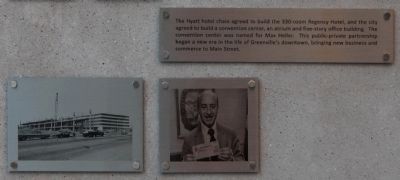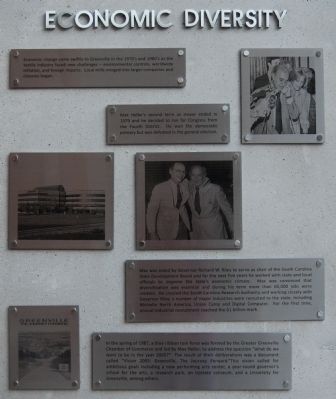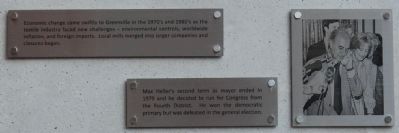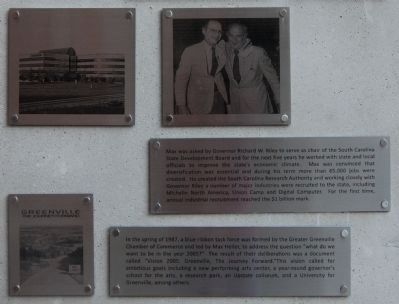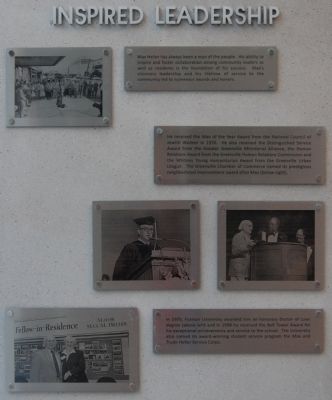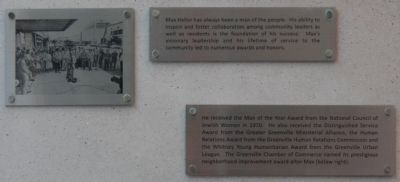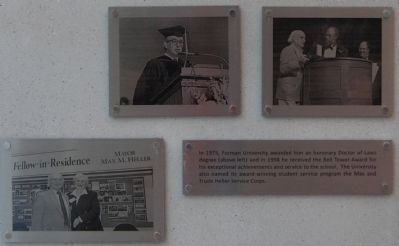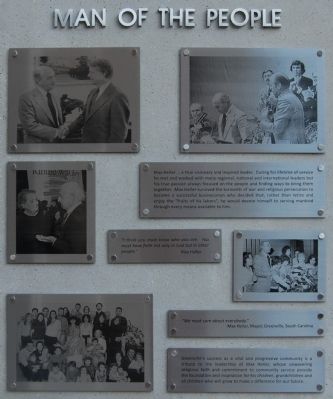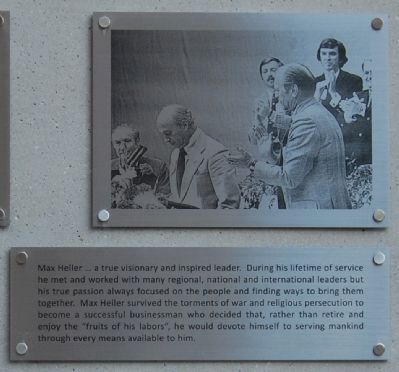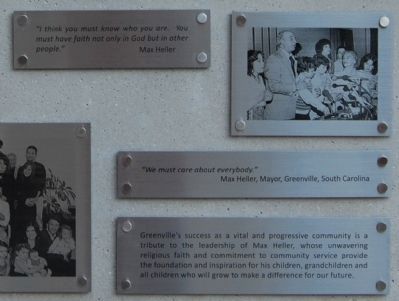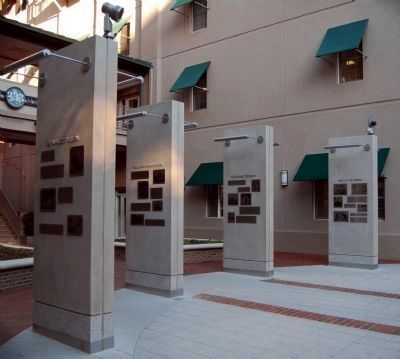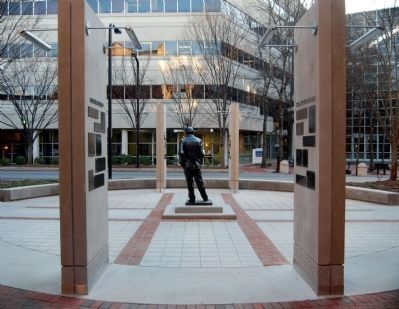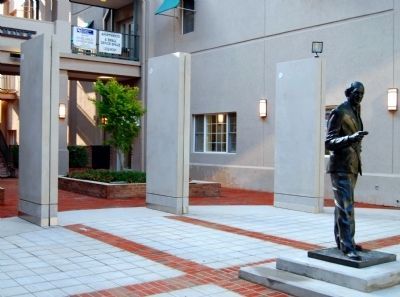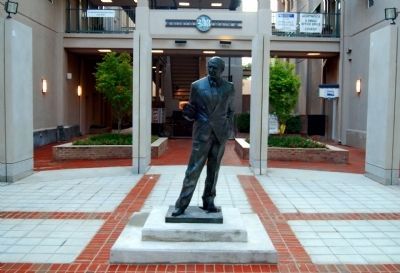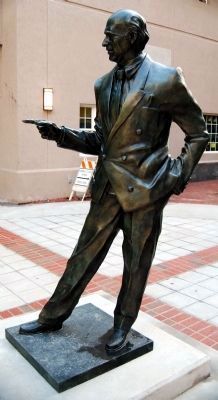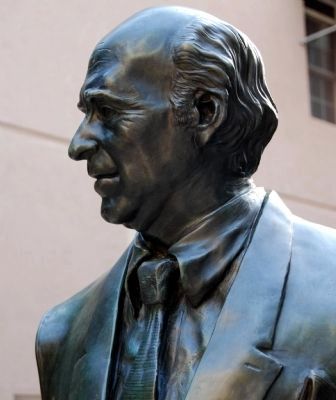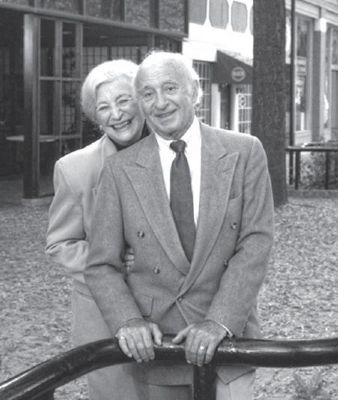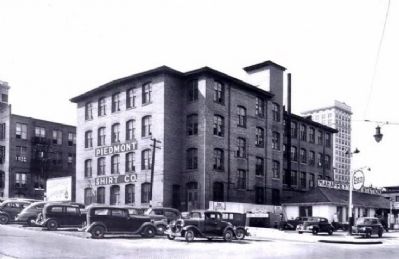Greenville in Greenville County, South Carolina — The American South (South Atlantic)
Max Heller Legacy Plaza
It was 1919 and Greenville, South Carolina had emerged from World War I with a surge of patriotism and community spirit. Main Street was a center of activity and a building boom brought the Woodside Building, the Chamber of Commerce Building and the Poinsett Hotel to the downtown. The textile mills that circled the city were operating at full speed. It was an exciting time.
[Middle Panel]:
In Vienna, Austria, on May 28, 1919, Max Heller was born to Israel and Leah Heller. In the photo, Max's sister Paula is on the left, his mother Leah in the center and Max on the right. Max grew up with a firm family foundation and a strong work ethic which carried him forward with vision and insight.
[Bottom Panel]:
After graduating from high school, he went to work in the wholesale business and was soon promoted to foreman and then buyer. This determination and strength of character would lead him to become, in later life, one of the driving forces in the revitalization of Greenville, South Carolina.
In 1938 Wehrmacht troops entered Austria to enforce the Anschluss of annexation of Austria and Nazi Germany. The stories of persecution, imprisonment and murder became very real for the Jewish community. Jewish stores were plundered, businesses confiscated and Jews in Vienna began to fear for their lives. Israel Heller lost his business and Max lost his job.
[Top Panel 2]:
"We couldn't accept the stories that people were being persecuted and killed just because they were Jews." -- Max Heller
[Bottom Panel 1]:
A year earlier, Max had gone out dancing and met Mary Mills and her four young friends from Greenville, South Carolina who were on a European tour. Mary gave Max her address in Greenville.
[Bottom Panel 2]:
Events overseas and the threat of American involvement in a second world war were having an effect on everyone in Greenville. Increasing efforts were made to support the allies in Europe and aggressive preparations began for the defense of American soil.
Tensions mounted in Austria. Swastikas adorned every building, every uniform, and every flag. Grocery stores were plundered; Jewish-owned buildings were burned. Park benches core signs saying "No Jews Allowed". It was time for Max Heller and his family to leave the country.
[Top Panel 2]:
Max wrote to his friend Mary Mills asking her if she could arrange for a sponsor in Greenville. She contacted Shepard Saltzman, owner of Piedmont Shirt Factory, who agreed to sponsor Max and his sister Paula.
[Bottom Panel 1]:
Soon Max and Paula were on their way to Paris and then to America on the Ile de France. After a short visit in Newark with his mother's sister, Max headed to Greenville.
[Bottom Panel 2]:
Greenville was continuing to gear up for support of the war in Europe. Orders flooded into local textile mills and soon they were operating eighty hours a week. Relief packages and money were collected by the local Red Cross and sent to the allies in Britain and France. Volunteers were enlisted to make bandages and garments to be sent overseas.
When Max's train arrived in Greenville, he was met at the train station by Shepard Saltzman, Mary Mills and several of her companions from the Vienna trip and Rabbi Mazure. Max only had $1.60 in his pocket.
[Bottom Panel 1]:
Mr. Saltzman invited Max to lunch but Max insisted on paying...five cents for a cup of soup. Before the day was out Max was at work at Piedmont Shirt Factory and a new career had begun.
[Bottom Panel 2]:
A greater step toward involvement in World War II for Greenville County residents came when Congress passed the first peacetime draft in American history on
September 16, 1940. Not waiting for the draft, hundreds volunteered for the Army, Navy and Marine Corps. The War Department selected Greenville, SC as the site for a new Army airfield to support the buildup for the War. In June 1942 the Greenville Army Base was officially activated as a twin-engine bomber training base for replacement aircrews, being assigned to the III Bomber Command of Third Air Force.
When Max Heller was 18, he met a young girl named Trude Schonthal at a summer resort and fell in live with her. He told her that summer that someday they would be married.
When Austria fell to Nazi Germany, Trude's family tried to get visas to the United States but no more were available. Her father escaped to Belgium and after hiding in the woods for five weeks, Trude and her mother finally crossed into Belgium. Trude and her mother eventually sailed to New York and later were joined by her father. In the summer of 1941 Max went to New York to visit Trude for the first time since they parted in Vienna.
[Bottom Panel]:
Mr. Saltzman, Max's employer, later brought Max's family over to the United States and Trude's family moved down to Greenville. The two families were united and Max and Trude were married in August of 1942. Mr. Saltzman gave both fathers jobs in his shirt factory.
During World War II rationing and air raid drills became a way of life in Greenville. Community drives for relied, the purchase of war bonds and the collection of scrap metal became routine in wartime Greenville. textile mills, local utilities and the municipal airport employed extra security guards to prevent sabotage. The Nineteenth Army Air Force Glider Pilot Training Detachment was headquartered at Furman University and received flight training at the municipal airport.
Max Heller began working in the Piedmont Shirt Factory sweeping floors and carrying shirt boxes. He worked 70 to 80 hours a week and there was no overtime pay. His first paycheck was for $10 with a dime taken out for Social Security.
[Bottom Two Panels]:
One day a co-worker told him to report to the front office because a judge wanted to see him. Max was terrified because he thought they were going to send him back to Austria. The man who greeted him was Judge John Plyler, the new president of Furman University, and he offered to help Max improve his English.
When the foreman of the shipping department left the company, Max asked for the job and got it. Soon he was made internal sales manager, and by the time he was 26 he was General Manager of the company.
By 1945 Max had become vice president of Piedmont Shirt Company. The company had offices in the Empire State Building in New york and opened a new plant in Walterboro, SC to make Wing shirts.
[Middle Panel]:
Max had promised Shepard Saltzman that he would never leave his employ unless he established his own company. However, in 1945, not content to work in someone else's business forever, he started the Williamston Shirt Company with two partners. The partnership was short-lived and in 1948 he sold his share and opened the Maxon Shirt Company in Greenville with sixteen employees. The business prospered under his energetic leadership and by 1962, the company had 700 employees.
[Bottom Panel]:
By this time the Hellers had three children -- Francie, Susan and Steven. They were active members of Congregation Beth Israel, where Max served as president of the synagogue. At the end of the War, Max and Trudie searched for displaced members of their families in Europe but located only two cousins. All of the others had died at the hands of the Nazis.
Greenville emerged from World War II as a prosperous, growing community. The textile industry was flourishing. The Memorial Auditorium was built downtown in 1959 and a new
Textile Hall opened on the newly completed US 29 Bypass in 1964.
[Middle and Bottom Two Panels]:
The opening of the Greenville-Spartanburg Airport and Greenville Technical College in 1962 added valuable resources to the area.
"I was never interested in being the richest man in the cemetery." -- Max Heller
Max decided that he wanted to devote his time to community service, so he sold his business in 1962 but by contract remained with the company for five more years, retiring officially in 1968. One of the community projects of which Max is so proud involves a citizens' group concerned about youthful offenders. Their work resulted in a law being passed in the legislature establishing a youthful offender's camp in Greenville County. Max has always been proud of this accomplishment.
Max Heller was elected to the Greenville City Council in 1968, where he focused his attention on improving substandard housing and making housing affordable for all.
In 1971, he was elected mayor of Greenville. From the beginning his vision was to bring people together and to create a city government for everyone. He desegregated all departments and commissions in city government and, working with the Police chief Harold Jennings, made [sure] certain police department practices were color-blind. The people of Greenville embraced Max's vision and the city was integrated in a peaceful fashion.
[Middle Panel]:
Greenville's first African American to serve on City Council was elected in 1977. The photo on the left shows the Council from 1977 to 1979. Back row, from left to right, Thomas C. Gower, Rev. Rayfield Medcalf, Harry B. Luthi, Jesse L. Helms; front row, James H. Simkins, Max M. Heller, and Patricia C. Haskell.
[Bottom Panel]:
The key to Mayor Heller's success was his love for people. Very little happened in City Hall that didn't involve citizen input. He became a driving force for environmental protection, beautification, slum clearance, economic rejuvenation, downtown revitalization and public-private partnerships.
Max Heller continued to be concerned for youthful and first-time offenders. In an attempt to control youth violence in Greenville, Max formed a Youth Advisory Committee and appointed as chair a young man who was president of his high school student body -- Knox White who in 1995 became mayor of Greenville. The committee consulted with the city and police officers to bring the youth perspective to government especially relating to recreation and youth violence.
[Middle Panel 1]:
When
Duke Power Company informed the city that it could no longer operate the municipal bus system, Max worked to create the Greenville Transit Authority. He asked Thomas Barton, president of Greenville Technical college to train bus drivers and local churches volunteered the use of buses to cover the transition.
[Middle Panel 2]:
"We must cherish our samenesses because we have many more samenesses than we do differences...and our main sameness is they we are all God's children." -- Max Heller
[Bottom Panel]:
In 1975, in a further attempt to bring people together and foster a more cohesive city, Max created the Mayor's Prayer Breakfast, open to all denominations. Even though there was some opposition, most religious leaders supported the breakfast.
The late 1950s and early 1960s saw the decline of downtown Greenville as large outlaying shopping centers were built. Store closed and were boarded up. streets became deserted. At the first meeting of the new Downtown Greenville Association, Charles Daniel told the members that the city was "unclean and neither attractive nor competitive with comparable progressive cities."
In an effort to renew downtown, Charles Daniel broke ground for his new headquarters on North Main Street in 1964. When
completed in 1967, it was the tallest building in South Carolina. At the same time the Greenville News-Piedmont announced plans to build its new headquarters on South Main Street.
[Bottom Panel 1]:
Under Max Heller's leadership, the revitalization of downtown became a priority in the 1970s. With the help of leaders like Buck Mickel, C. Thomas Wyche, and Alester G. Furman, Jr., a Total Development Plan was initiated by the Chamber of Commerce in 1976. The site of the Woman's College was renamed Heritage Green and there a new county library, the Charles E. Daniel Theatre, and the Greenville County Museum of Art were built.
[Bottom Panel 2]:
Max Heller's vision of an attractive, inviting, prosperous downtown would eventually become a reality through continued efforts by Mayors William D. Workman, Jr. and Knox White. Today, Greenville's downtown is a showplace and a national model for downtown redevelopment.
Max Heller's vision really began to take shape in late 1978 when the City of Greenville received a federal Urban Development Action Grant for $7.4 million, one of the first in the nation. With these funds the city began to acquire land on North Main Street and through the active involvement of Buck Mickel and C. Thomas Wyche, a new hotel and convention center was planned.
[Middle Panel]:
The Hyatt hotel chain agreed to build the 330-room Regency Hotel, and the city agreed to build a convention center, an atrium and five-story office building. The convention center was named for Max Heller. This public-private partnership began a new era in the life of Greenville's downtown, bringing new business and commerce to Main Street.
[Bottom Panel]:
The success of the Hyatt Regency was the impetus for the construction of two large office buildings across Church Street by U.S. Shelter. Revenue sharing funds paid for sidewalks and landscaping. The Coffee street Mall, now Piazza Bergamo, was constructed, and the old Meyers-Arnold Building was transformed into a center for the sale of arts and crafts.
Economic change came swiftly to Greenville in the 1970s and 1980s as the textile industry faced new challenges -- environmental controls, worldwide inflation, and foreign imports. Local mills merged into larger companies and closures began.
Max Heller's second term as mayor ended in 1979 and he decided to run for Congress from the Fourth District. He won the Democratic primary but was defeated in the general election.
[Bottom Two Panels]:
Max was asked by Governor Richard W. Riley
to serve as chair of the South Carolina State Development Board and for the next five years he worked with state and local officials to improve the state's economic climate. Max was convinced that diversification was essential and during his term more than 65,000 jobs were created. He created the South Carolina Research Authority and working closely with Governor Riley a number of major industries were recruited to the state, including Michelin North America, Union Camp and Digital Computer. For the first time, annual industrial recruitment reached the $1 billion mark.
In the spring of 1987, a blue ribbon task force was formed by the Greater Greenville Chamber of Commerce and led by Max Heller, to address the question, "What do we want to be in the year 2005?" The result of their deliberations was a document called "Vision 2005: Greenville, the Journey Forward." This vision called for ambitious goals, including a new performing arts center, a year-round governor's school for the arts, a research park, an Upstate coliseum, and a University for Greenville, among others.
Max Heller has always been a man of the people. His ability to inspire and foster collaboration among community leaders as well as residents is the foundation of his success. Max's visionary leadership and his lifetime
of service to the community led to numerous awards and honors.
He received the Man of the Year Award from the National Council of Jewish Women in 1970. He also received the Distinguished Service Award from the Greater Greenville Ministerial Alliance, the Human Relations Award from the Greenville Human Relations Commission and the Whitney Young Humanitarian Award from the Greenville Urban League. The Greenville Chamber of Commerce named its prestigious neighborhood improvement award after Max.
[Bottom Panel]:
In 1975, Furman University awarded him an honorary Doctor of Laws degree and in 1998 he received the Bell Tower Award for his exceptional achievements and service to the school. The University also named its award-winning student services program the Max and Trudie Heller Service Corps.
Max Heller...a true visionary and inspired leader. During his lifetime of service he met and worked with many regional, national and international leaders but his true passion always focused on the people and finding ways to bring them together. Max Heller survived the torments of war and religious persecution to become a successful businessman who decided that, rather than retire and enjoy the "fruits of his labors", he would devote himself to serving mankind through every means available to him.
[Bottom Three Panels]:
"I think you must know who you are. You must have faith not only in God but in other people." -- Max Heller
"We must care about everybody." -- Max Heller, Mayor, Greenville, South Carolina
Greenville's success as a vital and progressive community is a tribute to the leadership of Max Heller, whose unwavering religious faith and commitment to community service provide the foundation and inspiration for his children, grandchildren and all children who will grow to make a difference for our future.
Erected 2009 by Friends of Max on Main.
Topics. This historical marker is listed in these topic lists: Industry & Commerce • Patriots & Patriotism • War, World II. A significant historical month for this entry is May 1857.
Location. 34° 51.2′ N, 82° 23.867′ W. Marker is in Greenville, South Carolina, in Greenville County. Marker is on North Main Street just south of College Street (U.S. 25), on the right when traveling south. Touch for map. Marker is at or near this postal address: 233 North Main Street, Greenville SC 29607, United States of America. Touch for directions.
Other nearby markers. At least 10 other markers are within walking distance of this marker. Mrs. James Williams (about 600 feet away, measured in a direct line); Springwood Cemetery (about 600 feet away); Buncombe Street Methodist Church (about
700 feet away); Greenville County Confederate Monument (about 700 feet away); General Robert E. Lee (about 700 feet away); Eighty Unnamed Soldiers (about 700 feet away); The Buncombe Road (about 800 feet away); SC Ordinance of Secession (about 800 feet away); Confederate Armory (about 800 feet away); In Memory of 81st Wildcat Division / Camp Sevier (about 800 feet away). Touch for a list and map of all markers in Greenville.
Also see . . . Max Heller. A glimpse into the life of Max Heller, former mayor of Greenville South Carolina. (Submitted on January 29, 2010, by Brian Scott of Anderson, South Carolina.)
Additional commentary.
1. Short Biography and Max and Trudie Heller
On March 11, 1938 Max M. Heller left work and witnessed the Nazi take-over of Austria. Jewish synagogues and Jewish property were being vandalized and burned.
After Max lost his job and his family were forced to sell their silverware and jewelry to survive, Max and other family members were sponsored
to come to the U.S. by Shepherd Saltzman, a Jewish man who owned Piedmont Shirt company in Greenville, SC.
Leaving his Nazi-occupied homeland in 1938, Max came to Greenville to work as a stock boy at Piedmont Shirt Co. Trude and her family members fled to Belgium, then Holland, and family on to England, and them Greenville, SC.
Max founded Maxon Shirt Company in 1948 and retired in 1969, devoting his time to public service. In 1971, after two years on the Greenville City Council, he was elected and served two consecutive terms as mayor of Greenville. He was a candidate for the United States House of Representatives in 1978.
A former chair of the State Development Board, he has played a leadership role in civic and community organizations. Furman awarded him an honorary Doctor of Laws degree in 1975.
Max and his wife, Trude, who received an honorary degree from Furman in 1999, have 3 children, 10 grand-children, and 5 great-grandchildren. (Source: www.columbiaholocausteducation.org/.)
— Submitted January 30, 2010, by Brian Scott of Anderson, South Carolina.
2. Agents of Change: Max Heller
Max Heller Former mayor of Greenville, 1971–1979
Field of Impact Downtown Greenville
In his words: "I could not go into some parks because I was Jewish. I could not get certain jobs because I was Jewish. If I was sick, I had to see a Jewish doctor. I saw people beaten because they were Jewish. And then here I come to the land of the free. I’m accepted with open arms. How could I not be grateful?"
Ninety years old and suffering bouts of debilitating back pain, Max Heller still speaks his mind with vigor and conviction: “Take nothing for granted,” he says. An Upstate legend credited with initiating downtown Greenville’s revitalization thirty years ago, Heller is anything but complacent. And he has a message for those who want to see the city continue to thrive in the future—and shine even more brightly.
“Take care of the trees, plant the flowers,” he says. “Take nothing for granted.”
If Greenville’s appealing downtown continues to make a strong impression on both visitor and long-time resident alike, it’s because an Austrian Jew fled Nazi genocide in 1938, arrived in Greenville, worked as a stockboy at Piedmont Shirt Company, founded his own business in 1948 (Maxon Shirt Company), served two years on Greenville City Council, and in 1971 won election to the first of two terms as mayor of Greenville.
If Greenville sparkles, it’s because Max Heller made his home among us. “He pointed the way,” says current Greenville
mayor Knox White.
Heller became mayor at a time when Greenville’s Main Street was “pretty well shuttered-up, really devastated,” says White. Cars drove through downtown, quickly, not stopping. Heller had an idea that was “unusual for the time,” says White. He would invite an urban planner to redesign downtown. He would narrow the lanes to slow traffic, ask restaurants to put tables on the sidewalk, plant trees and flowers.
He would make Greenville’s center a pedestrian-friendly, European-style downtown. “Where I grew up, there were flowers and trees everywhere,” says Heller. “There was always natural beauty. I told the architect for downtown, ‘Give me that, give me a people place.’”
It was easier said than done. Many resisted change, as people do, says Heller. “There was a petition against us.” But he persevered.
An early success for Heller was garnering the Hyatt Hotel downtown, spurring other positive developments. Over thirty years there were advances and retreats, but the long arc of the years bent toward progress.
Three decades later: “I look at downtown with joy,” he says, giving credit to business leaders of the time, including Buck Mickel, Tommy Wyche, and Allester G. Furman. He also credits Mayor White and other city leaders, past and present, with maintaining
the momentum, extending downtown revitalization to encompass the West End.
Heller left Austria in 1938, as Jewish synagogues and property were being burned and vandalized. Memories of Nazi oppression gave Heller his strong sense of social justice. Asked what he’s most proud of, it’s not downtown, it’s the social progress that has been made, with people of all races and faiths growing more tolerant of each other.
It was with immense pride that Heller saw the unveiling of a statue of himself downtown on his ninetieth birthday last May. The statue and the North Main Street plaza that houses it -— appropriately named Legacy Park -— draws parallels between Heller’s life and downtown’s growth, says Ken Betsch, managing principal of Betsch Associates, whose firm designed the square. And the larger-than-life Heller, his head inclined and right arm extended, seems to be making a point: perhaps something about carrying on the legacy of the city’s forward-looking leaders. —Paul Hyde (Source: G: The Magazine of Greenville, January 2010.)
— Submitted January 30, 2010, by Brian Scott of Anderson, South Carolina.
3. Greenville Honors Contributions of Former Mayor Max Heller with Statue on Main Street
GSA Business
by James T. Hammond
May 29, 2009
The City of Greenville marked with a statue on Main Street the life and leadership of Max Heller, an Austrian Jewish refugee who fled Nazi genocide in 1938 to become an Upstate icon of economic renewal.
Unveiled on his 90th birthday Thursday, the bronze, larger-than-life casting depicts a middle-age Heller, his feet appearing to stride forward, and his right arm extended, his finger pointing. At right, Heller's great grandson, Charlie Moses, poses with the new monument.
The sculptor is Thomas J. Durham, a graduate of the College of Charleston and resident of Philadelphia. The monument was funded by “Friends of Max on Main,” comprising about 140 private and corporate donors.
Heller’s public life started with his election to city council in 1968. He focused on improving substandard housing and expanding affordable housing. He was elected mayor of Greenville in 1971. A major thrust of his work as mayor was to desegregate all departments and commissions of city government, and to erase differences in treatment between the races by police.
He also emphasized improvements in the treatment of youthful and first-time offenders. He formed a Youth Advisory Committee and appointed Knox White – the current mayor of Greenville – to chair the panel.
In 1975, he started the Mayor’s Prayer Breakfast, open to
people of all faiths. Despite some opposition, most religious leaders support the outreach.
Heller’s major endeavor as mayor was to reverse the decay of Greenville’s core. Most retail stores had abandoned Main Street for the suburbs. His European heritage told him a city without a heart would rot from within. With the backing of leaders including Buck Mickel, Tommy Wyche and Allester G. Furman Jr., he set out to attract a major anchor to start the redevelopment of Main Street.
In 1978, the city received a federal Urban Development Action Grant for $7.4 million, which was used to buy land on North Main Street. On that site at College and Main, a new hotel and convention center was built. Today, it is a Hyatt Hotel, and remains a strong centerpiece of North Main Street’s redevelopment.
When Richard W. Riley was elected governor in 1978, he asked his friend Max Heller to serve as chairman of the State Development Board, then the state’s chief instrument of economic development. Heller served for five years, and with Riley brought new businesses to South Carolina that ultimately created 65,000 jobs. He created the South Carolina Research Authority, and helped recruit Michelin North America, Union Camp and Digital Computer. During Heller’s tenure as the state’s chief industrial recruiter, annual new investment reached $1 billion for the first time.
At
the unveiling of Heller’s statue, Riley described his appointment of Heller to the Development Board as “the most important appointment I made as governor.”
Heller performed the service to South Carolina with no salary, Riley said.
Minor Mickel Shaw, whose father, the late Buck Mickel, worked on many projects with Heller, said they took on tough projects in the face of great obstacles.
“They had a dream,” Shaw said. “Many communities would have given up. But not Max and his SWAT team – Buck, Tommy and others.”
Their approach, she said, was “to dream higher and work harder and always have the next big project on the drawing board.”
Mayor Knox White said Legacy Park, the name of the Main Street location for the Heller statue, is appropriate description of Heller’s life.
“It reminds us of the legacy he has passed along, a legacy of Greenville as an open and welcoming community,” White said. “Little did he know how important that would be as we became an international city.”
— Submitted January 29, 2010, by Brian Scott of Anderson, South Carolina.
4. Jewish Settlers in the Upstate
Between 1880 and 1930, at a time when the Carolina upcountry was wielding
the political power it had wrested from the lowcountry, Jewish populations in Spartanburg, Greenville, and Anderson more than quadrupled, thanks to an influx of eastern Europeans. Orthodox but beardless, Greenville's new Jews first held services in rented halls, then built Synagogue Beth Israel on Towne Street. Charles Zaglin, from Wilmington, North Carolina, became the community's shohet. Harris Bloom acted as religious lay leader and his hon Julius as cantor. Most of the newcomers opened stores or worked as tradesmen, repairing shows and watches. One family ran a barber shop, another a cigar factory. With the growth of a managerial sector in the textile industry, Greenville acquired a salaried class.
I'm a born again Jew, you have to remember that. I was born again in Greenville. Greenville became my home. The only thing I miss about Vienna was the music. That's the only thing, when I hear it. Yes, and the outdoor cafes. One reason you see those outdoor cafes [when I became mayor] I said, "We have to have outdoor cafes in Greenville." -- Max Heller (b. 1919, Vienna, Austria)
An unanticipated in-migration of Jews fleeing Hitler added dramatically to the Jewish communities of the Piedmont. Between 1937 and 1947, Greenville's Jewish population increased by more than 40 percent, from 183 to 260, while Spartanburg's jumped by 90 percent from 98 to 170. Max Heller, who would go on to become major of Greenville from 1971 to 1979, was one of these refugees. Heller fled Austria in 1938 as the Nazis were closing in and came to Greenville to work in a shirt factory. The woman he would marry, Trude Schonthal, narrowly escaped from Vienna with her mother after the Nazis occupied Austria. It was nine months until they heard from Trude's father and nine months more until they saw him again. (Source: A Portion of the People: Three Hundred Years of Southern Jewish Life by Theodore and Dale Rosengarten, and the McKissick Museum (2002), pg 174.)
— Submitted January 30, 2010, by Brian Scott of Anderson, South Carolina.
5. 1978 Congressional Election
A more damaging issue evolved from [Carol] Campbell's successful campaign for Congress in 1978 against Greenville major Max Heller, who as an eighteen-year-old Jewish youth in Austria managed to escape the Nazi occupation by immigrating to the United States. He settled in Greenville after reaching out to someone he had met who had been touring Europe. Heller moved over time from a floor sweeper to owner of a small manufacturing plant, became active in civic affairs, and served two terms as a progressive and popular mayor before running as the Democratic candidate for Congress against Campbell. In 1978 Heller had spearheaded the beginning of upscale development in a badly deteriorated downtown Greenville, an effort reflected in today's vibrant Main Street shops and eateries and the outstanding twenty-first-century Upcountry History Museum.
Campbell's campaign polled voters, asking of they would vote "for a candidate who was a Jew," "for a foreign-born Jew," and, then, a reported third question, "for a foreign-born Jew who didn't believe in the Lord Jesus Christ." Late in the campaign and after a meeting with Campbell's campaign manager, garage owner Don Sprouse got on the ballot as a petition candidate. He asserted on television that Heller, who had been leading in the polls, should not be elected to Congress because he was not a Christian and did not "believe Jesus Christ has come yet." Sprouse received 1,700 of the roughly 100,000 votes. Campbell defeated Heller by almost 6,000 votes. (Source: The Palmetto State: The Making of Modern South Carolina by Jack Bass and W. Scott Poole (2009), pg. 153.)
— Submitted January 30, 2010, by Brian Scott of Anderson, South Carolina.
6. Max Heller: Community Servant
Furman University's annual Founders Day convocation celebrates our heritage and recognizes those who have helped enhance the Furman Experience
and the Greenville community.
Max Heller is one of these people. His rise to prominence in Greenville parallels Furman's own emergence from a small sectarian college to an independent, nationally prominent liberal arts institution.
Heller's remarkable story is worth repeating. It begins in 1937 in Vienna, when the eighteen-year-old Austrian met five charming young women from Greenville who were touring Europe. Seven months later, when Nazi troops were taking over his homeland and terrorizing the Jews, Max wrote to one of the Greenville girls, Mary Mills, and asked her to help him escape to the United States. She eagerly agreed to sponsor Heller and his sister and reported that she also had found him a job.
Penniless and knowing little English, Max arrived in Greenville in August 1938 and began work an hour later as a stock boy sweeping floors in the Piedmont Shirt Company. The next day a coworker told him to report to the front office because "a judge wants to see you." Heller feared the worst. "When I heard that a judge wanted to see me I was terrified," he recalled. "I thought that he was going to send me back to Austria."
At the front office, Heller was greeted by Judge John Plyler. He was a "stately, handsome man" who extended his hand and welcomed the young immigrant to Greenville. He "offered to help me learn to speak English and told me that he had just been named president of Furman University."
At that moment, Heller remembered, "I knew I had found a home in Greenville. It was then that I learned the great lesson that a simple act of kindness can mean so very much."
It wasn't long before the enterprising young man had become vice president of the shirt company. In the meantime, Max's parents had also escaped Nazi oppression and had come to America, as had the lovely young woman who was to be his bride.
Trude and Max married in 1942. They lost ninety members of their families during the Holocaust, but in Greenville they quickly established a new life together. By 1948 Max had started a company of his own, Maxon Shirt Company, which grew into a major textile enterprise.
Max also became actively involved in his adopted community, and twenty years after founding his company, he sold it to devote himself full time to serving Greenville, his state, and his synagogue. During the two distinguished terms as mayor, he led the way in revitalizing downtown Greenville. He also served as president of the chamber of commerce and as chair of the state development board.
Through the years, Max and Trude, who has been a community leader in her own right, have been very involved with Furman. Max has been a longtime member of our advisory council and a special friend of the Collegiate Educational Service Corps, an organization that enrolls more than fifteen hundred students who serve as volunteers in some seventy-five social service agencies in Greenville County. "The Service Corps is what is so wonderful about Furman," Heller explains. "It embraces the community. Furman reaches out to people. It is inclusive."
In 1975 Furman awarded Max an honorary doctor of laws degree, and in 1984 Trude received the Mary Mildred Sullivan Award for noble and humanitarian service. In recent years they have established several scholarships at Furman, one of which is named for Mary Mills Roberson, the woman who helped Max escape to America.
Max and Trude exude a love of life, of people, and of giving to their community that deserves recognition and emulation. They are an inspiration to those of us lucky enough to have lived in this country all of our lives -- and perhaps take our good fortune for granted. "My wife and I," Max says, "had a terrible experience [under the Nazis] and you can come out of that two ways: bitter or more appreciative of life."
For those who believe it is better to light a candle than curse the darkness, Max Heller provides a bright model of a life well lived. We can all benefit from his outstanding example. (Source: The Bell Tower and Beyond: Reflections on Learning and Living by David E. Shi (2002), pgs 122-123.)
— Submitted March 12, 2010, by Brian Scott of Anderson, South Carolina.
7. Max Heller has Never Stopped Giving
by Michelle and Michael Shain
May 24, 2009
Max on Main in Legacy Plaza will be dedicated at 4 p.m. Thursday, which happens to be Mayor Max Heller's 90th birthday. The physical address is 233 N. Main. It will represent our community's thank you to a man who has never stopped giving forward since he arrived in Greenville, South Carolina.
It started with a letter. She could have let the letter go unanswered but she didn't. That is not the Greenville way.
Mary Mills Roberson received a letter from young Max Heller, a man she met with four of her friends while they were in Vienna, Austria, on a European tour during the summer of 1937. Those other friends were Louise Jordan Earle, Elizabeth Lucas Marchant, Gee Gee Cogswell McCuen and Sallie Brown Clark Huguenin. They only met briefly and danced. In Max Heller's letter, he asked Mary Mills to help him escape to the United States of America in the wake of Hitler's terror in Austria.
Mary Mills found a way. She found a sponsor in Shep Saltzman, and Max Heller came to Greenville in August of 1938. His family and soon-to-be wife, Trude, soon followed. History will be forever changed with
that one small act of kindness from a very young woman who felt called to help. The actions of Mary Mills embody the Greenville we all know and love, a place where people are willing to step up to serve others in need.
Max will tell you that many people helped him along the way, people like Judge John Plyler, president of Furman University, Buck Mickel and Tommy Wyche. No one does this work alone.
His leadership as mayor of Greenville was one of inclusion not exclusion. He walked the talk of diversity before it had a name. He had vision and was not afraid to stand up for it even in the face of public outcry. He has lived the American Dream.
Joe Webber of the city of Greenville has been standing watch over the statue of Max Heller since this past winter. Joe has worked for the city since before Max Heller was first mayor. He remembers Mayor Heller's dapper style of dressing and says that the artist, Tom Durham, got the statue right.
A volunteer steering committee has been working to help make this happen, too many to name. They have worked to create a public plaza that will be a gathering spot for everyone who wants to sit and watch the world go by. The plaza will include the history of the legacy of the honorable Mayor Max Heller.
This committee has worked in a public-private partnership with the city, private foundations, professionals,
individuals, the county and with the help of the Community Foundation of Greenville. A special thank you goes yo Debbie Cooper of the Community Foundation of Greenville who has gone above and beyond to help us in our mission. As Max Heller will remind us, no one does this work alone.
As part of the Heller legacy, Max and Trude have taught their family what it means to give forward to the next generation. Heller's vision and determination have helped to create the magic that is our Main Street.
Other leaders have followed him and stood on his shoulders to continue that work. They too have stood watch over Main Street and helped make it stronger and more beautiful. It is now up to all of us to protect it and be good stewards of its future course.
It begs the question of what legacy will the next generation of leaders leave us? Who is the next Max Heller? It also illustrates that you do not have to be old to have wisdom and to change history. Who is the next Mary Mills?
Max Heller will now permanently stand watch over Main Street. Standing across from the Hyatt where the renaissance all began, the statue stands watch over a charming, two-lane, tree-lined, twinkle-light strung, people-filled Main Street that we all use to woo our families, friends and business associates.
We invite you to join us in this celebration. If you would like to make a donation to the Max on Main project you may make your checks payable to the Community Foundation of Greenville, Inc., 27 Cleveland St., Suite 101, Greenville, S.C. 29601.
— Submitted March 12, 2010, by Brian Scott of Anderson, South Carolina.
Credits. This page was last revised on December 13, 2019. It was originally submitted on January 29, 2010, by Brian Scott of Anderson, South Carolina. This page has been viewed 6,770 times since then and 106 times this year. Photos: 1, 2, 3, 4, 5, 6, 7, 8, 9, 10, 11, 12, 13, 14, 15, 16, 17, 18, 19, 20, 21, 22, 23, 24, 25, 26. submitted on January 29, 2010, by Brian Scott of Anderson, South Carolina. 27, 28, 29, 30, 31, 32, 33, 34, 35, 36, 37, 38, 39, 40, 41, 42, 43, 44, 45, 46, 47, 48, 49, 50, 51, 52, 53, 54, 55, 56, 57, 58, 59, 60. submitted on January 30, 2010, by Brian Scott of Anderson, South Carolina. 61. submitted on March 12, 2010, by Brian Scott of Anderson, South Carolina. • Craig Swain was the editor who published this page.
